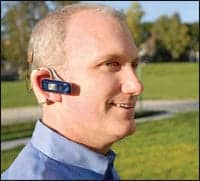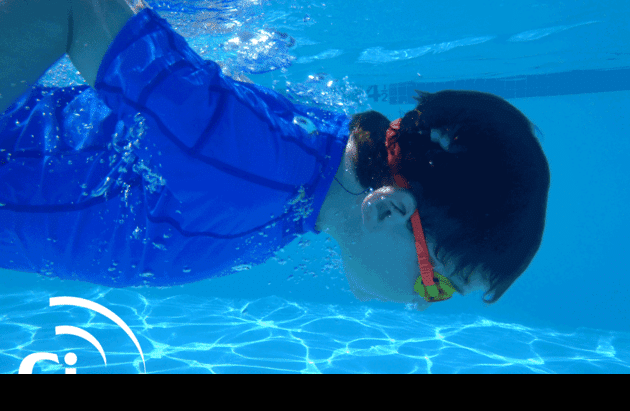The German-owned company receives positive feedback as it markets its cutting-edge hearing technology to an American audience.

While the RetroX is still in the infancy of its US marketing (some 1,000 patients are currently using it), Auric’s US-based president, David Navaroli, believes the US patient market for the RetroX could grow to ultimately rival that of the 2 million conventional hearing aid patients in the United States. “The market niche that the product was developed for was those individuals who want to hear without blocking their ears, and that is a large niche,” says Navaroli. A majority of individuals who would benefit from conventional hearing aids are not wearing them, Navaroli says, because they are in some way uncomfortable with them. For these patients, Auric believes, the RetroX could represent a long-awaited solution.
In approving the RetroX, Navaroli says, the Food and Drug Administration (FDA) has recognized the utility and uniqueness of the product. “We’ve spent the past 3 years working with the FDA to get the RetroX to the US market,” Navaroli says, “and we were happy that they determined that we were unique enough to warrant a unique designation.”
Catering to Unmet Patient Needs
Like many medical innovations, the RetroX is proving to be a creative and constructive development that owes its origins to unmet patient needs. In 1996, in Germany, a patient found herself continuously displeased with a conventional hearing aid. “So the audiologist snaked the tube into her open ear canal,” Navaroli says, and the patient reportedly was thrilled with its performance. “That gave these practitioners [an audiologist, an ear, nose, and throat specialist, and engineers] the idea for the concept of RetroX,” he says.
The RetroX is not just being met with impressive patient satisfaction. It also is proving to be competitive on price. Navaroli says Auric has not yet aggressively sought managed care or governmental reimbursement contracts, but he contends that the RetroX is proving “less expensive than a conventional hearing aid solution for most patients.” Costs associated for the product include three components: an elective surgical procedure (requiring only a local anesthetic) for the tube fitting, professional fees for the hearing aid programming, and the hearing aid itself (which resembles other high-quality digital hearing aids). Auric currently is in discussions with an undisclosed financial institution to arrange private financing plans for the RetroX. Such an arrangement, if formalized, may afford RetroX patients greater flexibility in purchasing the product.
To date, Navaroli says, US marketing for the RetroX has been focused primarily on developing local testimonials for the RetroX that ultimately can be profiled in future marketing collateral, advertising, or other promotions. “We’ve attended the major conventions, and we are engaging practices that expressed an interest so they can develop local testimonials before we go after national advertising. We want the initial clients to be happy,” he says, “and we want all of the hearing professionals to be excited about the outcomes.”
Outcomes Look Promising
Such outcomes, so far, are proving promising. “In one situation,” says Navaroli, “we had an audiologist who obtained a pair of simulators, qualified 12 candidates for the RetroX, and the ear, nose, and throat doctor began performing the tube fitting procedure, and they received excellent customer satisfaction.” The result was contagious. “Now,” he says, “another supplier in that town has obtained simulators, so they can begin identifying RetroX candidates. In this case, an audiologist is simulating and dispensing, a hearing aid supplier is simulating and dispensing, and an ear, nose, and throat doctor is performing the tube fitting, and that’s how we see it working.”
In a more objective performance study of 80 RetroX patients in Germany, reported by Auric, there were no operative complications from the insertion of the device’s tubing; only one patient reported postoperative discomfort from the procedure, and this was subsequently resolved with refitting.
Seeking to expand product familiarization for the RetroX, Auric recently developed a range of marketing collateral (including an advertisement recently published in this magazine) that it will be distributing in the United States this year. “We have videos, brochures, mini posters, and that’s all just being released now,” says Navaroli.
Targeting the Market
The company’s US marketing currently is targeted heavily toward hearing professionals, though prospective patients do not include those being served satisfactorily with conventional hearing aids. The patient market, instead, includes those with impaired hearing who have opted against treatment with conventional hearing aids because they were uncomfortable with the instrumentation, or patients who currently are dissatisfied with their conventional hearing aids.
“Currently,” Navaroli says, “the hearing professionals are our local salespeople. They already know, or can identify, the people who can benefit from this.” And while the RetroX is being used in the treatment of common “ski slope” hearing losses, Auric believes the product’s technology holds the potential for the treatment of other hearing loss conditions. “The RetroX is just the beginning,” says Navaroli. “The tube is a conduit for sound information that shows tremendous promise.”
Auric currently generates approximately $10 million in worldwide revenues and employs about 100 employees, though only a few of these are US-based. In the United States, Navaroli says, “we expect to add support staff as necessary to meet demand.” Currently, though, he says that Auric is proving able to fill product and service demand for the RetroX with limited personnel resources. “Most providers are able to take the information we provide them [on the RetroX] and run with it,” he says.
Ease of implementation, an opportunity to assess the effectiveness of the RetroX prior to full implementation, and preliminary patient satisfaction reports all point to an exciting future for RetroX. “We developed this product because too many people are not having their needs met by conventional hearing aids,” Navaroli observes. “They don’t want anything in their ear, and that’s what we deliver, and that makes a lot of folks happy.”
Auric’s Charlotte, NC-based US headquarters is available to answer inquiries from hearing professionals and patients through its toll-free phone line, (866) 872-8742.
Michael Johns is a Melville, NY-based health care writer. He has served previously as vice president of a Fortune 1000 health care corporation, senior associate for a leading public affairs firm, and White House speechwriter to former President George H.W. Bush. He has written for CBS HealthWatch, Orthopedic Technology Review, and other leading health care publications.





